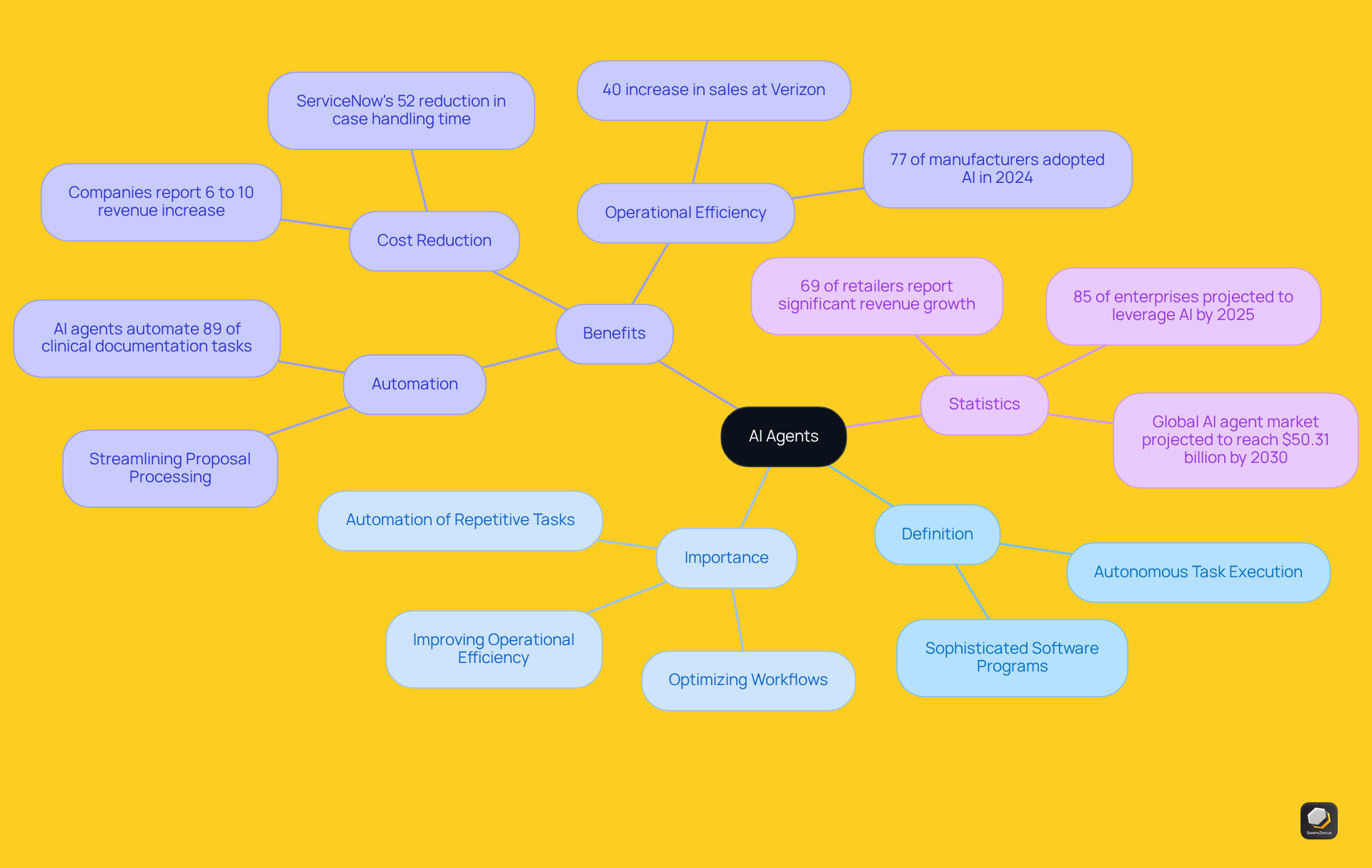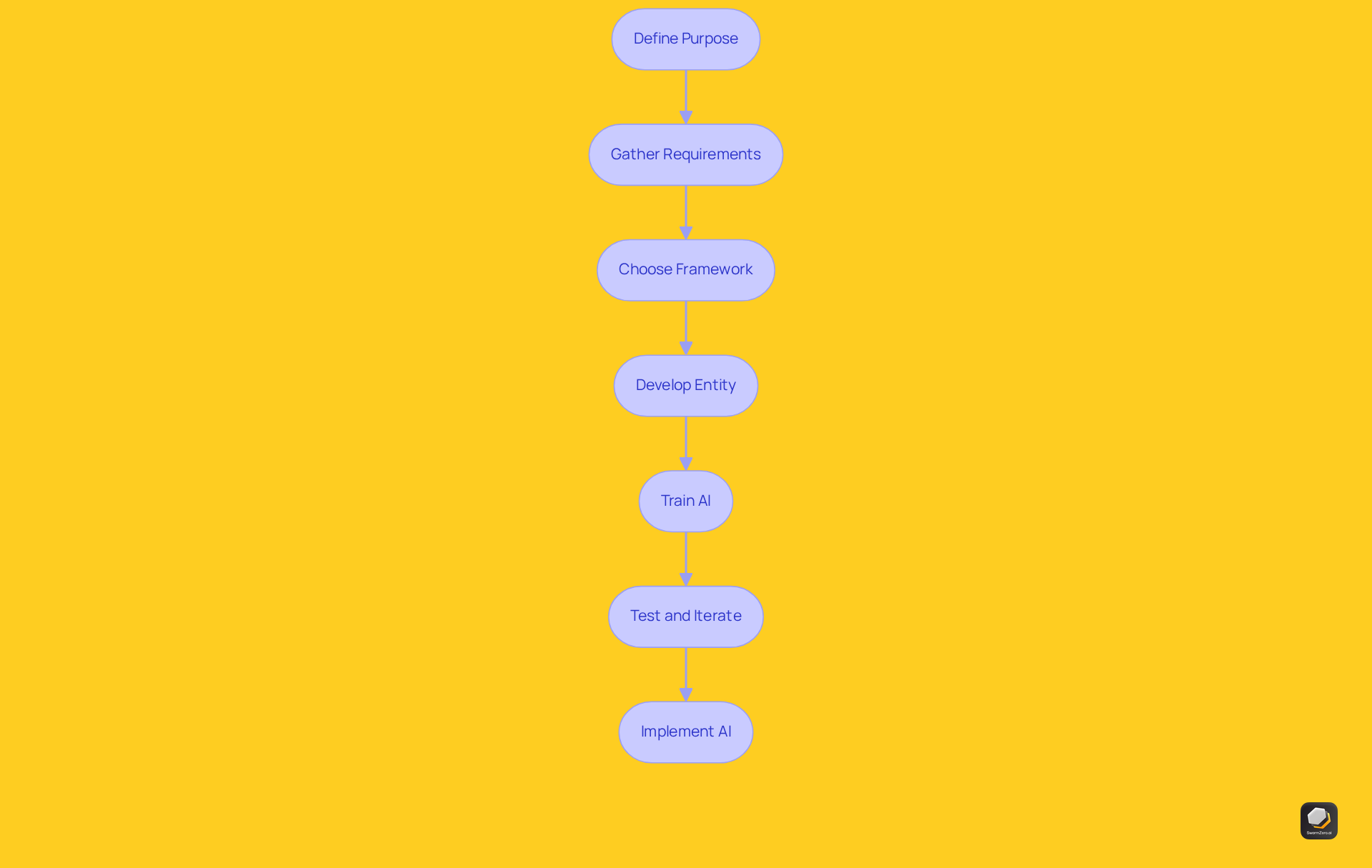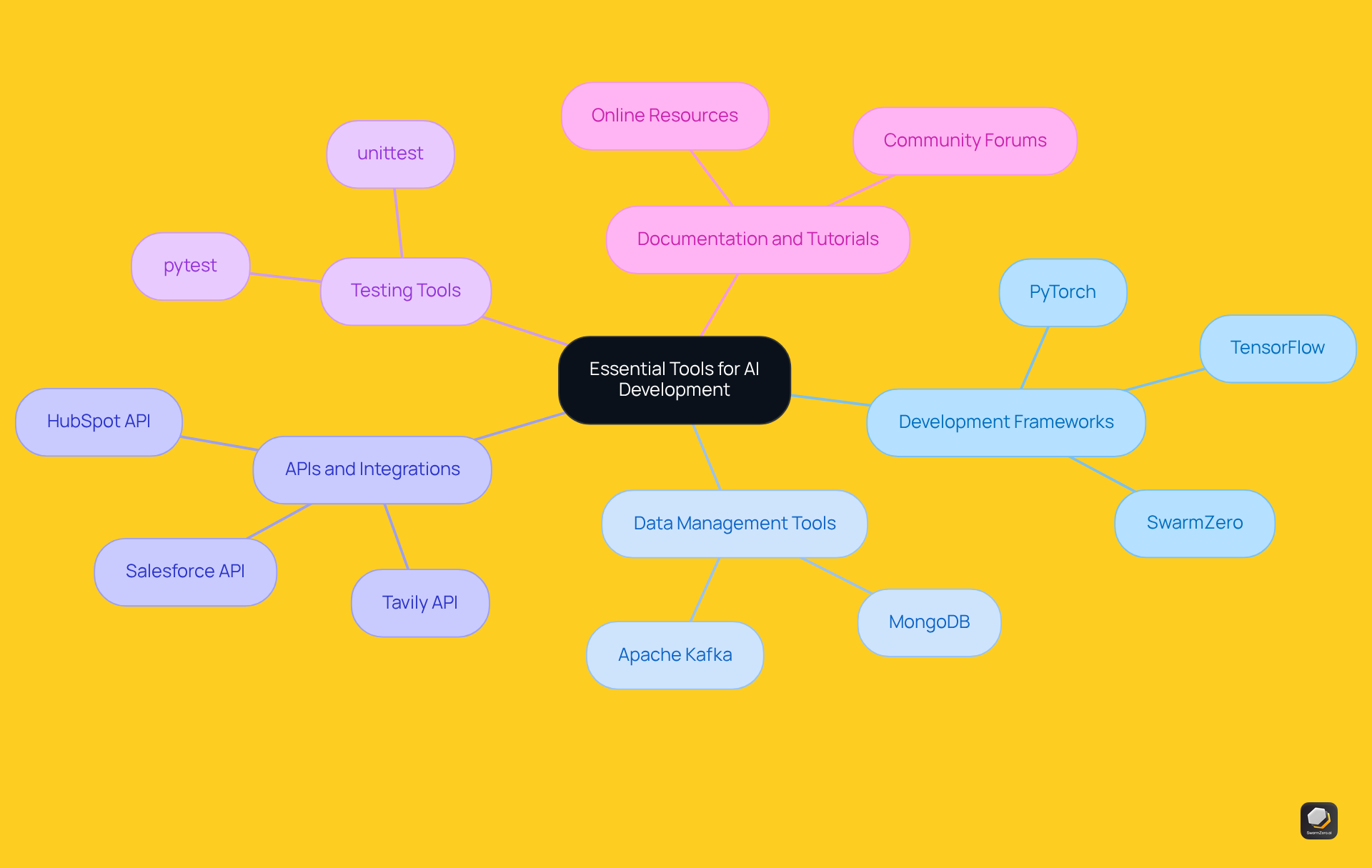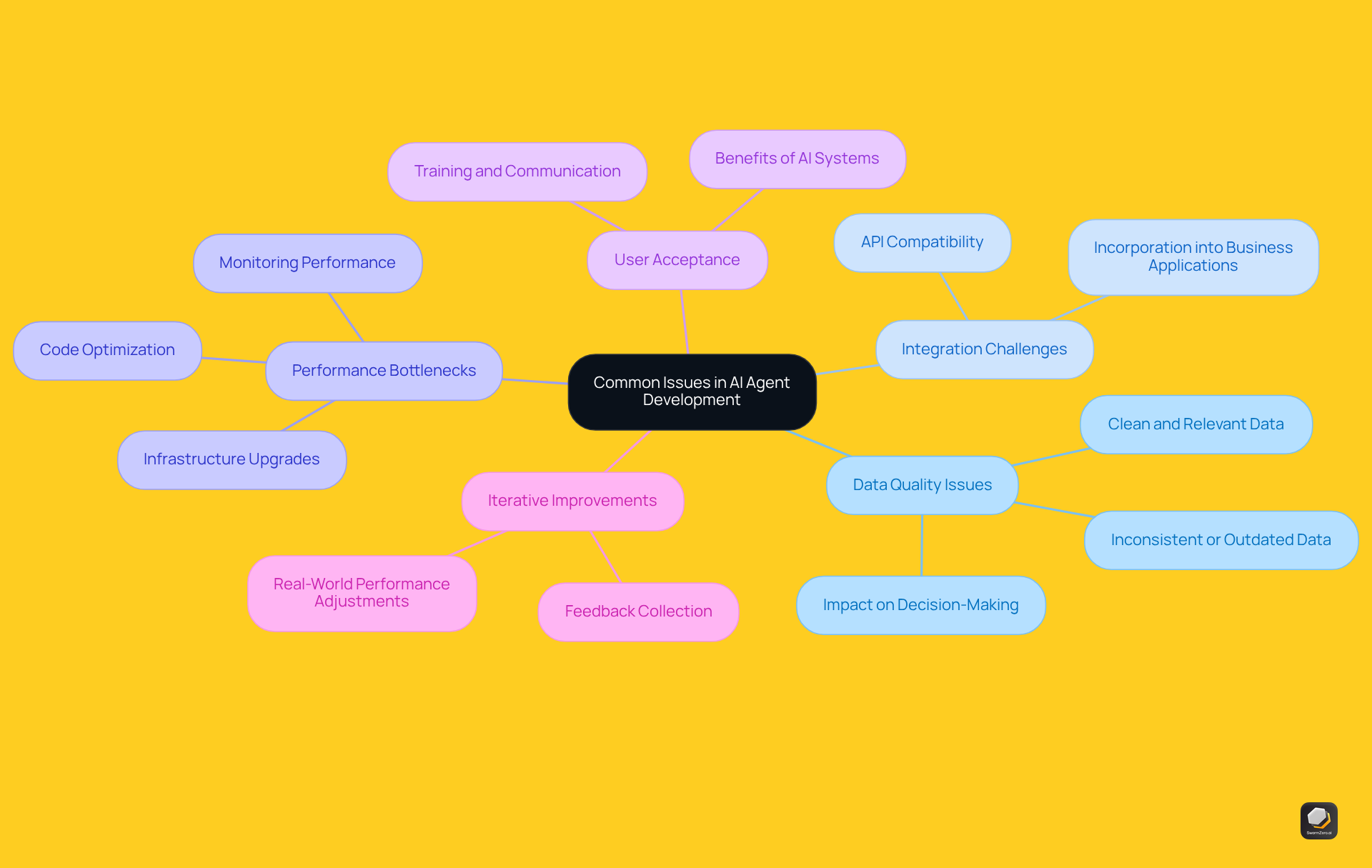How to Build an AI Agent System: Essential Steps and Tools
Learn essential steps and tools for effectively building an AI agent system.

Key Highlights:
- AI agents are autonomous software programmes that perform tasks without human intervention, enhancing operational efficiency.
- Companies using AI agents report revenue increases of 6% to 10% and significant reductions in customer service resolution times.
- 85% of enterprises are expected to adopt AI tools by 2025, highlighting the urgency for organisations to integrate these technologies.
- Key steps to build an AI agent system include defining purpose, gathering requirements, choosing frameworks, developing the entity, training, testing, and implementing.
- Essential tools for development include frameworks like TensorFlow and PyTorch, data management tools, APIs for integration, and testing frameworks.
- Common issues in AI development include data quality, integration challenges, performance bottlenecks, user acceptance, and the need for iterative improvements.
Introduction
The rise of artificial intelligence has transformed the technology landscape, enabling systems to perform complex tasks autonomously and efficiently. Organisations increasingly recognise the potential of AI agents to streamline operations and enhance productivity. Consequently, the demand for effective strategies to build these systems is on the rise. However, navigating the intricacies of AI agent development presents significant challenges.
What essential steps and tools are necessary to create a robust AI agent system that not only meets business objectives but also adapts to evolving needs?
Understand AI Agents: Definition and Importance
AI systems are sophisticated software programmes designed to autonomously execute tasks for users or other systems, leveraging artificial intelligence to analyse data, make informed decisions, and perform actions without human intervention. Their importance is underscored by the capacity to automate repetitive tasks, optimise workflows, and markedly improve operational efficiency.
For example, companies that implement agentic AI experience an average revenue increase of 6% to 10%, highlighting the tangible advantages of this technology. Additionally, organisations like ServiceNow have reported a remarkable 52% reduction in the time needed to resolve complex customer service cases, illustrating the operational efficiencies gained through AI integration.
By adopting AI technologies, businesses can not only reduce costs and enhance accuracy but also liberate human resources to focus on strategic initiatives that drive innovation. With 85% of enterprises projected to leverage AI tools by 2025, the imperative for organisations to adopt these solutions is clear.
Notably, the SwarmZero framework offers a comprehensive marketplace for developing, monetizing, and automating business solutions, featuring AI-driven web search tools that utilise the Tavily API to enhance search functionalities. This fundamental understanding of AI entities is crucial as we explore how to build an AI agent system effectively.

Follow These Steps to Build Your AI Agent System
-
Define the purpose of how to build an AI agent system by pinpointing the specific tasks that your AI system will undertake. This may involve automating customer service interactions, generating personalised sales proposals, or managing content creation for platforms like YouTube.
-
Gather Requirements: Identify both the technical and functional needs for your AI system. This includes comprehending how to build an AI agent system by understanding the necessary data inputs and the anticipated outcomes, ensuring that the representative aligns with your organisational goals.
-
Choose the Right Framework: Select a development framework that meets your needs. While choices like TensorFlow and PyTorch are well-regarded, specialised platforms such as SwarmZero offer tailored solutions on how to build an AI agent system effectively.
-
Develop the Entity: With your chosen framework, commence coding your AI entity. Focus on establishing a robust framework that illustrates how to build an AI agent system to efficiently manage the objectives outlined in your purpose definition.
-
Train the AI: Equip your AI system with relevant data to ensure effective training. This step is vital for understanding how to build an AI agent system that enables the representative to execute its assigned tasks accurately and efficiently.
-
Test and Iterate: Conduct comprehensive testing to uncover any issues. Utilise feedback to refine how to build an AI agent system's performance, making necessary adjustments to enhance its functionality.
-
Implement the AI: Following successful testing, integrate your artificial intelligence into the intended environment, ensuring seamless compatibility with existing frameworks and workflows. This final step is crucial for maximising the representative's impact on operational efficiency.

Identify Essential Tools and Resources for Development
To build an effective AI agent system, consider the following essential tools and resources:
- Development Frameworks: Opt for widely-used frameworks such as TensorFlow and PyTorch, or specialised platforms like SwarmZero. These options streamline the creation and deployment of AI agents. Notably, SwarmZero's integration with the Tavily API enhances web search capabilities, facilitating AI-powered processing that significantly improves search efficiency.
- Data Management Tools: Implement robust data management solutions like Apache Kafka for real-time data streaming and MongoDB for flexible data storage. These tools ensure your AI system has access to the necessary information.
- APIs and Integrations: Enhance your AI system's functionality by leveraging APIs from platforms like Salesforce and HubSpot. This facilitates seamless integration with existing systems and workflows. The Tavily API, employed within the SwarmZero framework, illustrates how robust integrations can elevate the capabilities of AI systems.
- Testing Tools: Utilise testing frameworks such as pytest or unittest to rigorously validate your AI system's performance and reliability prior to deployment. This ensures it meets operational standards.
- Documentation and Tutorials: Take advantage of online resources, tutorials, and community forums to gather insights and support throughout the development process. This fosters a deeper understanding of best practises and troubleshooting techniques.
By strategically choosing these tools and resources, developers can effectively streamline how to build an AI agent system. Ultimately, this results in improved operational efficiency and productivity. As the SwarmZero team states, "Our goal is to provide developers a seamless platform experience for creating entities that can assist with a variety of tasks across any industry.

Troubleshoot Common Issues in AI Agent Development
When developing AI agents, several common issues may arise:
-
Data Quality Issues: It is imperative to ensure that the data used for training is both clean and relevant. Subpar information quality can lead to flawed predictions and performance. Inconsistent, incomplete, or outdated data undermines confidence in analytics, resulting in stalled decision-making and strategic setbacks.
-
Integration Challenges: Should your AI system struggle to integrate with existing systems, it is advisable to review the API documentation and confirm compatibility. AI systems are increasingly being inherently incorporated into business applications to enhance efficiency, providing a broader context for addressing integration challenges.
-
Performance Bottlenecks: It is essential to monitor the representative's performance during testing. If it operates slowly, consider optimising the code or upgrading the infrastructure. AI systems can now achieve in hours what once required weeks for data preparation and quality assurance, underscoring the importance of addressing performance challenges.
-
User Acceptance: In instances where users resist adopting the AI system, it is crucial to provide training and clear communication regarding its benefits to foster acceptance. Well-defined AI entities can aid businesses in overcoming critical obstacles to fully realise the potential of AI, highlighting the significance of user acceptance in effective implementation.
-
Iterative Improvements: Continuously gathering feedback post-deployment is vital to identify areas for improvement and implement necessary adjustments to enhance functionality. Collecting feedback from end users during pilot programmes enables modifications based on real-world performance, ensuring that the AI system evolves to meet user needs and adapts to changing requirements.
By proactively addressing these challenges, organisations can significantly enhance their understanding of how to build an AI agent system, leading to improved operational efficiency and better alignment with business objectives.

Conclusion
Building an AI agent system is a transformative process that empowers organisations to harness the capabilities of artificial intelligence effectively. The integration of AI agents automates routine tasks and enhances operational efficiency, allowing businesses to focus on strategic growth. By understanding the essential steps and tools required for developing these systems, organisations can position themselves to leverage AI's full potential.
Key steps include:
- Defining the purpose of the AI agent
- Gathering requirements
- Selecting the right framework
- Implementing the system
Additionally, choosing appropriate tools, managing data effectively, and addressing common development challenges are crucial for ensuring successful deployment. These insights underline the significance of a structured approach to AI agent development, leading to substantial improvements in performance and user acceptance.
Embracing AI technology is no longer optional for forward-thinking organisations; it is a necessity for maintaining competitiveness in a rapidly evolving landscape. By following the outlined steps and utilising the recommended tools, businesses can create AI agents that meet their operational needs and drive innovation and growth. The time to act is now—invest in building an AI agent system to unlock new efficiencies and elevate your organisation's capabilities.
Frequently Asked Questions
What are AI agents?
AI agents are sophisticated software programmes designed to autonomously execute tasks for users or other systems, utilising artificial intelligence to analyse data, make informed decisions, and perform actions without human intervention.
Why are AI agents important?
AI agents are important because they can automate repetitive tasks, optimise workflows, and significantly improve operational efficiency. This leads to tangible benefits for businesses, such as increased revenue and reduced resolution times for customer service cases.
What are some benefits of implementing AI agents in businesses?
Implementing AI agents can result in an average revenue increase of 6% to 10% for companies. Additionally, organisations like ServiceNow have reported a 52% reduction in the time needed to resolve complex customer service cases.
How does adopting AI technologies affect human resources in businesses?
By adopting AI technologies, businesses can reduce costs and enhance accuracy, allowing human resources to focus on strategic initiatives that drive innovation.
What is the projected adoption rate of AI tools by enterprises?
It is projected that 85% of enterprises will leverage AI tools by 2025, indicating a strong trend towards the adoption of these solutions.
What is the SwarmZero framework?
The SwarmZero framework is a comprehensive marketplace for developing, monetizing, and automating business solutions, featuring AI-driven web search tools that utilise the Tavily API to enhance search functionalities.
List of Sources
- Understand AI Agents: Definition and Importance
- AI Agent Statistics for 2025: Adoption, ROI, Performance & More (https://plivo.com/blog/ai-agents-top-statistics)
- 35 AI Agent Statistics | Datagrid | Datagrid (https://datagrid.com/blog/ai-agent-statistics)
- 15+ AI Agents Statistics You Need to Know in 2025 (https://azilen.com/blog/ai-agents-statistics)
- 30+ Powerful AI Agents Statistics In 2025: Adoption & Insights (https://warmly.ai/p/blog/ai-agents-statistics)
- AI Agents Statistics & Market Trends For 2025: Growth & Impact (https://allaboutai.com/ai-agents/statistics)
- Follow These Steps to Build Your AI Agent System
- OpenAI Launches New Tools for Building AI Agents | PYMNTS.com (https://pymnts.com/news/artificial-intelligence/2025/openai-launches-new-tools-building-ai-agents)
- Build a Real-Time News AI Agent Using LangChain — In Just a Few Steps! (https://dev.to/pavanbelagatti/build-a-real-time-news-ai-agent-using-langchain-in-just-a-few-steps-4d60)
- Inside Agentforce: Creating AI Agents That Will Change Everything at Work (https://salesforce.com/news/stories/building-business-ai-agents)
- How to Build an AI Agent (https://salesforce.com/ca/agentforce/build-ai-agent)
- Identify Essential Tools and Resources for Development
- 25 Best AI Agent Platforms to Use in 2025 - Big Data Analytics News (https://bigdataanalyticsnews.com/best-ai-agent-platforms)
- The 10 Hottest Agentic AI Tools And Agents Of 2025 (So Far) (https://crn.com/news/ai/2025/10-hottest-agentic-ai-tools-and-agents-of-2025-so-far)
- New tools for building agents (https://openai.com/index/new-tools-for-building-agents)
- The Best AI Agents in 2025: Tools, Frameworks, and Platforms Compared (https://datacamp.com/blog/best-ai-agents)
- The 55 Best AI Tools in 2025 (Tried & Tested) (https://synthesia.io/post/ai-tools)
- Troubleshoot Common Issues in AI Agent Development
- Monte Carlo puts AI agents to work on data reliability - SiliconANGLE (https://siliconangle.com/2025/04/17/monte-carlo-puts-ai-agents-work-data-reliability)
- Building a News Fact-Checker AI Agent (https://datacamp.com/code-along/building-a-news-fact-checker-ai-agent)
- AI agents for data governance: A data leader’s guide to next-gen data quality (https://ataccama.com/blog/revolutionizing-data-quality-governance-with-ai-agents-the-ultimate-guide-for-data-leaders)
- How To Solve Data Readiness Bottlenecks With AI Agents (https://forbes.com/councils/forbestechcouncil/2025/01/09/how-to-solve-data-readiness-bottlenecks-with-ai-agents)
- Bulletproof AI agents that dont fail: Ensure Success – Gnani.ai (https://gnani.ai/resources/blogs/bulletproof-ai-agents-that-don-t-fail-ensure-success)




